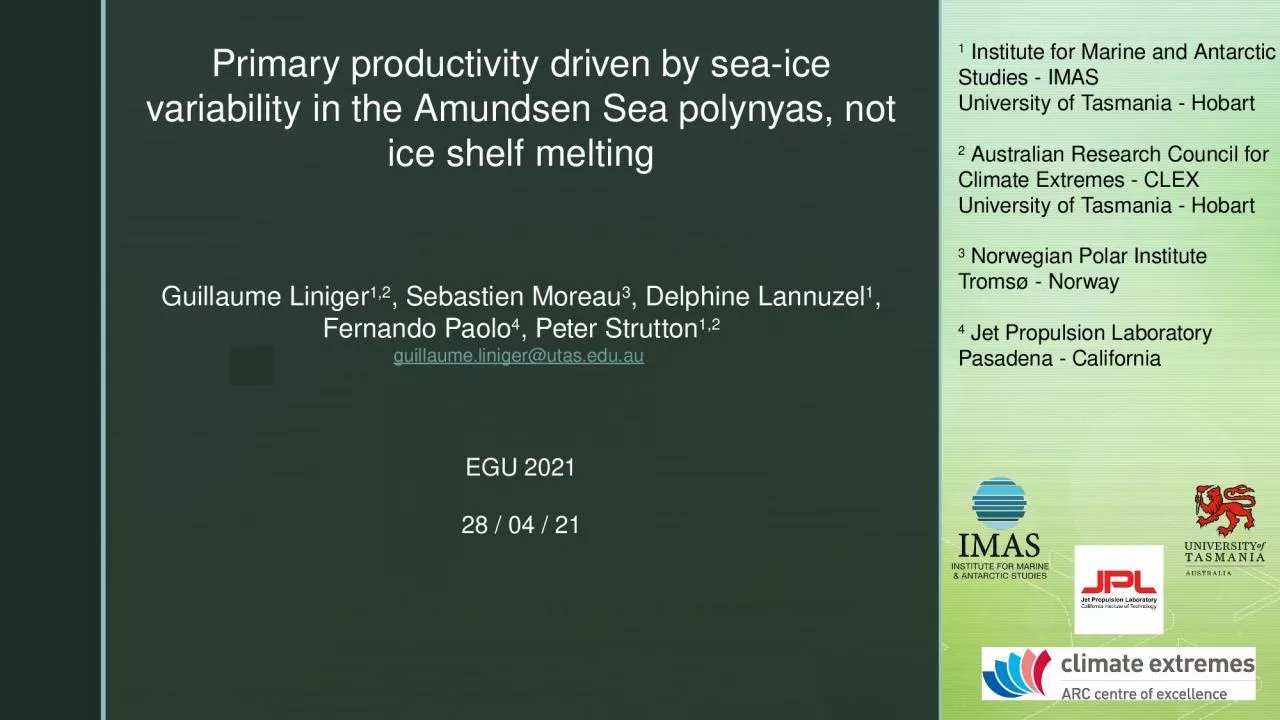

3 Delphine Lannuzel 1 Fernando Paolo 4 Peter Strutton 12 guillaumelinigerutaseduau EGU 2021 28 04 21 Primary productivity driven by seaice variability in the Amundsen Sea polynyas not ice shelf melting ID: 1024705
Download Presentation The PPT/PDF document "Guillaume Liniger 1,2 , Sebastien Moreau" is the property of its rightful owner. Permission is granted to download and print the materials on this web site for personal, non-commercial use only, and to display it on your personal computer provided you do not modify the materials and that you retain all copyright notices contained in the materials. By downloading content from our website, you accept the terms of this agreement.
1. Guillaume Liniger1,2, Sebastien Moreau3, Delphine Lannuzel1, Fernando Paolo4, Peter Strutton1,2guillaume.liniger@utas.edu.au EGU 202128 / 04 / 21Primary productivity driven by sea-ice variability in the Amundsen Sea polynyas, not ice shelf melting1 Institute for Marine and Antarctic Studies - IMASUniversity of Tasmania - Hobart2 Australian Research Council for Climate Extremes - CLEXUniversity of Tasmania - Hobart3 Norwegian Polar InstituteTromsø - Norway4 Jet Propulsion LaboratoryPasadena - California
2. Basal melt rate of Antarctic ice shelf (Rignot et al., 2013)(a) Change in grounding line ice discharge, (b) total change in mass for the time period 1979 - 2017 (Rignot et al., 2019)Thwaites : -634 GtPine Island : -1066 GtGetz : -363 Gt (a)(b)Basal melt rate and mass loss dominated by the Amundsen Sea Embayment in the WAIS1 Introduction - Aim
3. What impact such loss can have on the Amundsen polynyas primary productivity ?Coastal polynyas The most productive areas relative to their size Amundsen Sea polynyas The most productive around Antarctica ! (3.39 Tg C y-1)The highest biological productivityThe highest basal melt rate in the WAISThe Amundsen Sea (Arrigo et al., 2015; Morales-maqueda, 2004)Can we establish a link between both phenomena?Hypotheses :The interannual variability in biological production is driven by glacial meltA continued increase in ice shelves basal melt rate and ice discharge will translate into an increase in surface ocean primary productivity.1 Introduction - Aim
4. AntarcticaGtGtDtsTwPIGCsAbbASPPIP2 polynyas : Amundsen Sea (ASP) and Pine lsland (PIP)6 ice shelves : Abbot (Abb) Cosgrove (Cs) Pine Island (PIG) Thwaites (Tw) Dotson (Dts) Getz (Gt)2 Method
5. Satellite dataBiological variableNet Primary Productivity (NPP)Ice variablesSea-ice concentration (SIC)Ice fluxes (Rignot et al., 2019)Basal Melt Rate (Paolo et al., submitted)Other variablesSea Surface Temperature (SST)Data span 1998 – 2017Time series, maps and correlation constructed for that time periodMonthly and yearly resolutions2 Method
6. Annual primary productivity climatology for the Amundsen Sea and Pine island polynyas. The red lines represent the polynyas contoursGtGtDtsTwPIGCosAbbNet primary productivity time series for the Amundsen and Pine island polynyasSignificantly higher NPP in the Amundsen polynyaMax NPP located in central polynya for PIP, center east for ASP3 Results
7. 3 ResultsTime series of net primary productivity (NPP) with total volume loss rate (TVLR; red) and total ice fluxes (TIF; blue). NPP and total volume loss rate are calculated from October to March. Total Ice fluxes are calculated yearly from Rignot et al. (2019). TVLR and TIF annual integrals represent the sum of considered ice shelves for the ASP (Dts, Gt) and PIP (Abb, Cs, PIG, Tw). Significant higher TVLR and TIF in the PIPSignificant higher NPP in the ASPNo significant relationships between NPP with both TIF / TVLR in both polynyasASPPIP
8. 3 ResultsNet primary productivity (NPP) anomaly against (a) sea-ice concentration (SIC) and (b) sea surface temperature (SST) anomaly. (c) SIC anomaly against SST anomaly. Data are monthly mean from October to March spanning 1998 - 2017Significant negative correlation between NPP and SIC anomaly (a)Significant positive correlation between NPP and SST anomaly (b)Significant negative correlation between SIC and NPP anomaly (c) (a)(b)(c)
9. 3 ResultsSIC x Meridional windNPP x Wind stress curlSpatial correlation map between sea-ice concentration (SIC) and (a) meridional wind, and net primary productivity (NPP) with (b) wind stress curl. Data span 1998 – 2017 from October to March. The black crosses represent significant correlation at 95% confidence level. The black lines represent the polynyas boundariesSignificant negative correlation between SIC and meridional winds in both polynyas Significant positive correlations between NPP and wind stress curl in east ASP(a)(b)
10. 4 ConclusionsWe conclude ice shelves melting is not the primary factor impacting biological activity in the ASE polynyas over the last 2 decadesInstead, the SIC variability seems to play a major role, itself influenced by windIn the ASP : Lower SIC and upwelling where we observed our highest NPP Fe-enriched sediments resuspended from melt-laden pump near the ice shelves flowing to the central polynya and being upwelled to the surface sustain the bloom Fresh water from icebergs helps stratification and sustain productivity with released trapped-ironIn the PIP : SIC drives NPP variability too, but higher SIC on average Lower NPP compared to the ASP Potential stronger light limitation due the higher SIC Regenerated iron as contributor in the PIP sustaining the bloom (Dinniman et al., 2020; Bett et al., 2020; Park et al., 2017; Gerringa et al., 2020)
11. 5 Supplementary MaterialsScatter plots of monthly averaged net primary productivity (NPP) against (a) El Niño standardized anomaly and (b) Southern Annual Mode (SAM) and sea-ice concentration (SIC) with (c) El Niño and (d) SAM. Filled circles represent data from ASP, empty circles represent data from PIP. Data are monthly mean spanning October to March from 1998 to 2017. We suspected potential impact of larger climate forcing on NPP and SIC No significant relationships found between NPP / SIC with El Niño standardized anomaly and SAM